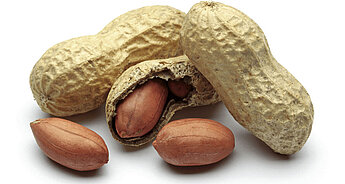Peanut allergy

Around 1 in 200 British children have a peanut allergy. Here's what causes it, and what you can do.
What is it?
Peanut allergy happens when the body reacts badly to the proteins found in peanuts (also called groundnuts, monkey nuts or earth nuts). It thinks these proteins are harmful and tries to attack them, causing allergic symptoms.
Peanuts are part of the ‘legume’ family, which includes beans and peas, and are different to ‘tree nuts’ like walnuts and hazelnuts. Some people are allergic to just one or the other, and others are allergic to both peanuts and tree nuts.
Who gets it?
Peanut allergy is one of the most common allergies in children, affecting around 1 in 200 kids in the UK. It is being diagnosed earlier, and more often in children. For about 1 in 5 children, peanut allergy will resolve itself; however, many people have peanut allergy for life.
Why does it happen?
Nobody really knows why a peanut allergy affects a certain person, but allergies do have a genetic link. This means that if others in your family have an allergy, it's more likely that you or your child will have an allergy too.
The Government used to recommend that pregnant women avoid eating peanuts, because it was thought this could increase the chance of the baby having a peanut allergy. However, more recent research has shown that this is not the case, and more studies are currently looking at why peanut allergy occurs.
What should you do if you think your child has a peanut allergy?
If, during weaning, you suspect your child has had an allergic reaction to a product containing peanuts, it's important not to give him or her anything containing peanut again until you have spoken to your GP. Your GP may want to take a family history or perform a skin prick test (SPT) or a blood test (called a RAST). If your child's symptoms are severe and obviously linked to peanuts, then this may not be required.
Is there a treatment?
The only treatment currently available for peanut allergy is to avoid all peanuts and peanut-containing products. (Care should also be taken with ‘tree nuts,’ as some people are allergic to both.) If your child is diagnosed with peanut allergy at a very young age, your GP may suggest re-introducing peanut (under medical supervision) at a later age to see if they have ‘grown out’ of it.
What do you need to avoid?
All peanuts and peanut-containing products, such as peanut butter, chocolate and nut spread, peanut sauces, peanut flour and peanut oil. If your child's peanut allergy is very severe, you'll need to take extra care to avoid even small traces of peanut in processed foods.
Label-checking is a must, especially on Eastern foods, cakes, desserts, biscuits, pastries, breads, cereals and confectionery. Supermarkets can provide lists of the nut-free products they carry, but it's always a good idea to check the ingredient lists yourself for the most up-to-date advice.
By law, peanut must be listed as an ingredient if it's included in the product. The term ‘this product may contain traces of nut’ is legally required on packaging if the product may have come into contact with nuts during the manufacturing process; however, this doesn't mean the product itself contains (or doesn't contain) nuts, so proceed with caution.
Dietary concerns
Peanuts are not a central part of most people's diet, so avoiding them shouldn't cause any nutritional problems. However, if you're worried that your baby is not getting proper nutrition because of a peanut allergy, you may want to see a dietitian for more advice.
HiPP products
All of HiPP's packaging is printed with a clear ingredients list; we also include a bright yellow 'CONTAINS' box underneath the ingredients list, to make things a bit easier. As of August 2015, no HiPP products contain peanuts; however, if one of our foods might contain traces of nuts, then you'll find that information in the 'CONTAINS' box.


